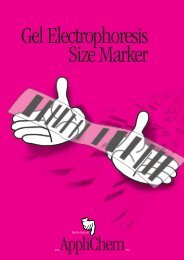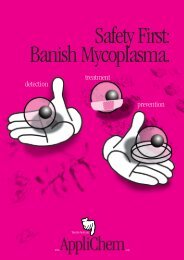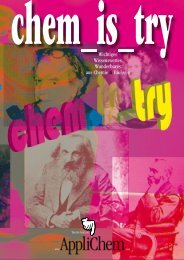Transfer Membranes
Transfer Membranes
Transfer Membranes
Create successful ePaper yourself
Turn your PDF publications into a flip-book with our unique Google optimized e-Paper software.
Background Problems<br />
While there are several ways to decontaminate probe solutions, the following methods are two of the most efficient.<br />
The second method can be rapidly performed with minimum effort.<br />
Method 1:<br />
Phenol/Chloroform extract the probe to remove unincorporated nucleotides, proteins, and other contaminants.<br />
Method 2:<br />
Clean the probe by adding a small volume of the hybridization buffer to the probe and filtering it through a Cameo 25AS low<br />
protein binding cellulose acetate syringe filter (GE Osmonics Catalog #DDA02025S0; available at AppliChem). Contaminants<br />
in the probe solution will be held back by the 0.2 µm filter with no probe loss caused by nonspecific binding to the filtration<br />
membrane.<br />
Probe length is also a factor contributing to background levels seen on transfer membranes. Between 250 – 800 base<br />
pairs is the recommended optimum length of a probe; probe lengths smaller or larger than this can lead to a low signalto-noise<br />
ratio. Probes smaller than 250 base pairs often bind poorly and may require less stringent hybridization and wash<br />
procedures. Probes larger than 800 base pairs may contain a wider variety of size classes, which can lead to extraneous<br />
binding to the transfer membrane.<br />
Hybridization Solution Related Background Problems<br />
Contaminated hybridization solutions are another common source of background problems. Hybridization solutions should<br />
be filtered with a pure cellulose acetate Cameo 25AS syringe filter ( GE Osmonics Catalog #DDA02025S0; available at<br />
AppliChem), to remove contaminants.<br />
Additionally, all solutions and buffers should be made fresh before each transfer with sterile, double-distilled, deionized<br />
water, and very high grade reagents. After fresh buffers are made, they should be filtered with a Cameo 25AS syringe filter<br />
(GE Osmonics Catalog #DDA02025S0; available at AppliChem) to ensure that no contaminants remain in the solution.<br />
Formamide-based hybridization solutions are a frequent source of background noise, and the formamide must be freshly<br />
made and deionized.<br />
DNA Dependent Background<br />
This type of background is caused by nonspecific annealing of the probe to the bound DNA or RNA, and can be eliminated<br />
by adjusting the stringency of both the hybridization and wash steps, and by the addition of heterologous DNA or RNA<br />
to the hybridization solutions. During the hybridization and prehybridization steps, a concentration of 0.1 – 1 % SDS is<br />
recommended for nylon membranes. Because the final wash step after the hybridization is the most important, AppliChem<br />
recommends:<br />
Northerns: 0.1X SSPE, 0.1 – 0.5 % SDS, for 30 minutes at 65°C.<br />
Southerns: 0.1X SSPE, 0.5 – 1 % SDS, for 30 minutes at 65°C.<br />
Optimized Blocking Solutions<br />
A concentration of 5 – 7X Denhardt’s solution is recommended for use with nylon membranes. Exceeding this level can<br />
lead to quenching of the signal.<br />
troubleshooting&tipsProbe Related<br />
Backgrounds Associated with Reprobing<br />
A follow-up autoradiograph after probe removal is strongly recommended to determine if the probe has been fully stripped.<br />
Otherwise, backgrounds can appear in blots that have not been fully erased.<br />
12 <strong>Transfer</strong> <strong>Membranes</strong> • AppliChem © 2008





